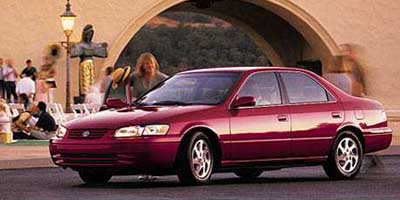New Car/Review

1999 Toyota Camry XLE
By Matt/Bob Hagin
 Toyota Full Line Video footage (15:01) 28.8, 56k, or 200k
Toyota Full Line Video footage (15:01) 28.8, 56k, or 200k
SPECIFICATIONS
Manufacturer's Suggested Retail Price $ 25,058
Price As Tested $ 27,021
Engine Type DOHC 24-valve 3.0 Liter V6 w/MFI*
Engine Size 183 cid/2995 cc
Horsepower 194 (192 in Ca.) @ 5200 RPM
Torque (lb-ft) 209 (207 in Ca.) @ 4400 RPM
Wheelbase/Width/Length 105.2"/70.1"/188.5"
Transmission Four-speed automatic
Curb Weight 3273 pounds
Fuel Capacity 18.5 gallons
Tires (F/R) 205/65HR15
Brakes (F/R) Disc (ABS)/disc (ABS)
Drive Train Front-engine/front-wheel-drive
Vehicle Type Five-passenger/four-door
Domestic Content 55-percent
Coefficient of Drag (Cd.) 0.30
PERFORMANCE
EPA Economy, miles per gallon
city/highway/average 20/28/26
0-60 MPH 8.5 seconds
1/4 mile (E.T,) 16.5 seconds @ 85,5 mph
Top-speed 130 mph
* Multi-point fuel injection
(The Toyota Camry marked the beginning of an upscale march that saw the company elevate itself past being just the producer of basic transportation buzzboxes, says Matt Hagin. His father Bob likes the changes but reflects on those early "basic" Toyotas with fond memories.)
BOB - Matt, Toyota has been importing passenger cars to the U.S. since the late 50's, but back then they were pretty spartan. The bodies of the cars were rust-prone, but the mechanical parts kept going until the cars disintegrated. Since then, the company has gone on to produce the Camry, which has been the Number One selling car in the U.S. for several years. The XLE V6 we had is the top-of-the-line Camry and it epitomizes the company's goal of making a semi-luxury family car that is classy rather than flashy. A family can cruise all day in this car at almost any speed and end the trip as refreshed as the moment they strapped themselves into the seats.
MATT - The Camry comes in a couple of different levels of power and convenience, Dad. The 3.0 liter V6 in our car is all-aluminum and is equipped with four valves per cylinder. It puts out 194 horses in most states and the torque is now up to 209 pound/feet. This pulls the 3300 pound four-door very well. Like almost all non-sports sedans, the Camry is front-wheel drive, but Toyota is edging the car into that market a bit by offering a five-speed manual transmission in the LE V6 version. I think that the company is a bit apprehensive about the Camry's "graying" customer base and wants to attract younger affluent buyers as well.
BOB - Toyota also offers the '99 Camry with a more "basic black" 2.2 liter four-banger for buyers who are less interested in keeping up with the Joneses and don't need to crack the sound barrier in commuter traffic. It puts out 133 ponies and when it's bolted up the standard five-speed stick-shift it can pull a little over 30 miles out of a gallon of fuel. The block is iron on the four cylinder unit and unlike the V6, it can get by on a diet of 87 octane gas by virtue of the fact that it has a full point lower compression ratio than its big brother.
MATT - The underpinnings of the Camry are pretty conventional, Dad. The suspension in front is the traditional MacPherson strut and the rear uses a dual link system. The shocks both front and rear are gas-filled and to stabilize the car a little more, all Camrys have front and rear sway-bars, but being a mechanic at heart, I noticed that the sway-bars on the four-cylinder job is a little bigger in diameter than the V6. I was also interested in the fact that the V6 comes with more antiquated disc brakes on both front and rear wheels, while the four has drum brakes in back.
BOB - Like most mid-size sedans on the market today, Matt, the Camry has a three-across rear seat with three, three-point shoulder belts, but I sure wouldn't want to travel very far in the back with two other guys as big as me. I liked the optional side seat air bags for the front seats and I'd like to see them offered for the rear as well. Traction control is optional on the V6, but only on cars with the automatic transmission. An anti-lock braking system (ABS) is standard on all Camrys with a V6 and optional on the four-cylinder LE trim, but to tell the truth, I'd like to see ABS, traction control and side air bags as standard across the board.
MATT - Our XLE tester had 15-inch aluminum rims mounting 205/65HR all-season tires and it had a full-sized spare, but it was mounted on a steel rim, This means that a driver whose car has had a flat is going to look slightly "funky" until the flat is fixed. It's that image thing again. The general styling of the new Camry is very slick, even though it's a three year-old design.
BOB - Toyota has gone to great lengths to make the Camry "slippery" with a drag coefficient of .030 which helps the car get its relatively high fuel mileage. With its 18.5 gallon gas tank, the Toyota guys say this XLE version has a range of over 500 miles on a single full tank.
MATT - We'll have to take their word for it, Dad, since I've rarely seen you drive much further than a ten-mile radius from your house.


